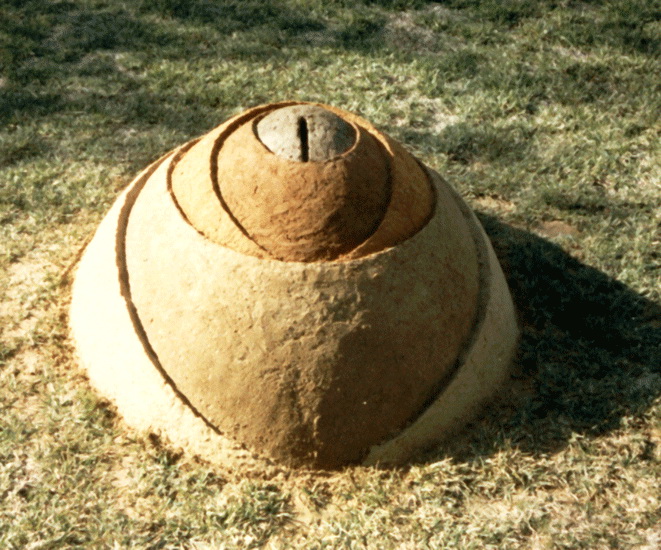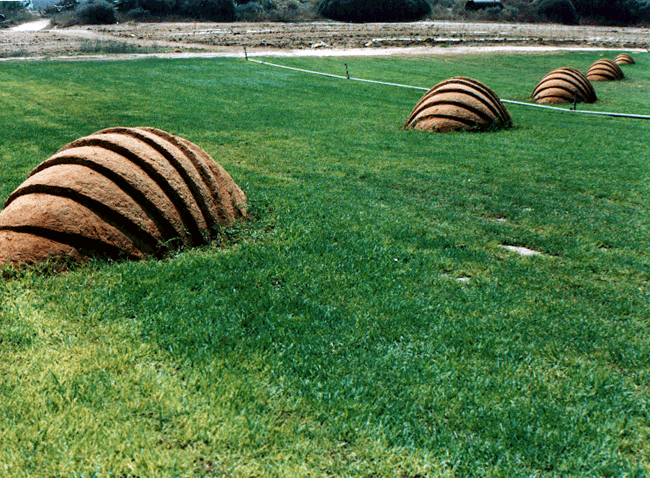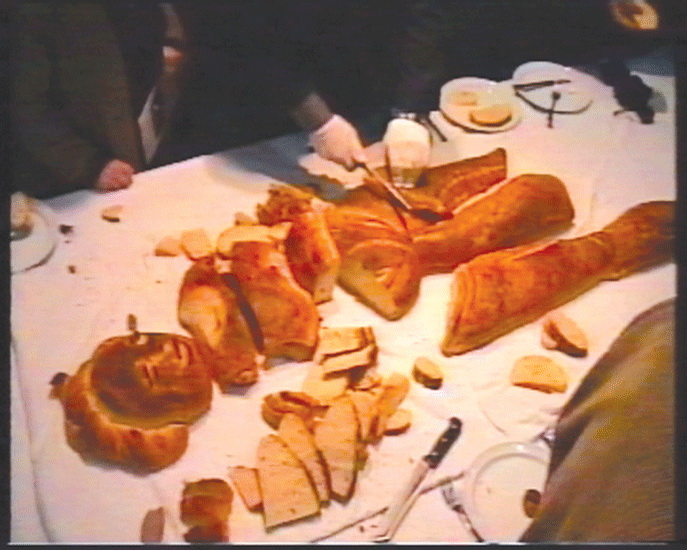by Anne Marie Champagne
"The task of the right eye is to peer into the telescope,I'd like to introduce you to Tanya Preminger, an artist whose breadth and scope of work spans it all except, perhaps, painting and printmaking. Primarily a sculptor and earthworks artist, I first happened upon a critique of her Mother Altars in a late 90's issue of Flash Art magazine and was immediately intrigued.
while the left eye peers into the microscope."
-- Max Ernst
ARTIST STATEMENT:
"My purpose is to express the immaterial essence of things in physical stuff: to make tangible the universal essence of creation."

"The Trinity". Photograph. 1998. Tanya Preminger.

"Sky and Earth". Basalt. 1996. Tanya Preminger.
Preminger's work explores themes of protection, vulnerability, femininity, motherhood, and sexuality, motifs which American audiences may recognize in the work of Louise Bourgeois. Yet, unlike Bourgeois, Preminger's sensitive approach to spacial relationships, as demonstrated in "Sky and Earth" (above), mitigates the sublimity -- the terror -- of her subject and object, allowing for an approachable intimacy of objects and forms redolent of Isamu Noguchi's more minimalist sculptures (e.g., "Shodo Shima Stone Study").
"Shodo Shima Stone Study". Noguchi.
image courtesy of www.walkerart.org
Many of Preminger's earthworks are executed with the same reverent spirit of earlier environmental artists. It is not difficult to find correlations to Michael Heizer's large-scale sculptures carved out of the earth, Robert Smithon's constructive approach, or Andy Goldsworthy's situational land art.
Two among my favorite of her earth works:

"Layers" 1988

"Reincarnation" 1989
Working in multiple mediums, including photography and installation art, Preminger is an artist in the fullest sense. Evading the trappings of rationalization, cynicism, and apathy, Preminger dares us to look deeply yet obliquely into the margins of life to discover along with her what we have heretofore misrecognized from the comfortable vantage of our presuppositions. She openly invites her audience to participate, not merely as passive voyeurs, but as co-creative conspirators, as evidenced by her 2002 installation piece "On the Table".

"On the Table". 2002. Installation. Bread, table, plates, glasses,cutlery.

Judy Chicago's feminist ceremonial banquet, "The Dinner Party."
(At Preminger's banquet, guests get to consume the art.)
Contrary to some critics, I do not view On The Table as a sexually savage act bordering on cannibalism. Preminger's treatment of sex, while admittedly forceful at times, is far more complex and intricately nuanced than her surfaces at first glance might suggest. Upon closer inspection, one detects a tension-filled reversal of all that is taken for granted between the sexes, and even this observation dissolves if held too long, giving way to an ever shifting paradox. In her installation, the feminine, the goddess, is the giver of life (as symbolized by bread), presented on a table doubling as an altar. If anything, Preminger's treatment of the feminine is sacramental, and her work, drawing upon nature's dichotomy, is more an alchemical synthesis of masculine and feminine vitality than a deconstruction of it.
Regarding the sexual dimension found in many of Preminger's pieces, in a review titled "The Great Goddess", Gideon Ofrat writes:
The sexual act suggested in Preminger's sculptures is the metaphysical-cosmic intercourse of heaven and earth. This is not an harmonious act of surrender. Rather, it is suffused with the enormous tension of sparring contrasts and the role reversal whereby femaleness gets the better of maleness. The reversal of traditional roles imposes on the earth obtuse maleness and on the sky female qualities.3 in the 1996 Sky and earth, which features two identical rectangular blocks, albeit contrasting in material and color, the white of the upper marble block penetrates the black of the basalt block lying underneath. In traditional terminology, heaven is fertilizing the earth (mother-earth). But in terms of Preminger's reversal, which imposes femaleness on the firmament, the woman possesses the man.What I find in Tanya Preminger's work is a viscerally arresting connection, though not always direct (hence oblique), between the soul and the external world, and it is this soulfulness that brings me back to her Mother Altars.
To learn more about Tanya Preminger and her art visit: www.tanyapreminger.com




No comments:
Post a Comment